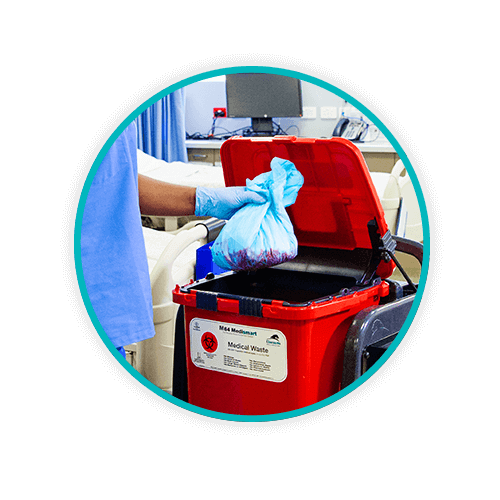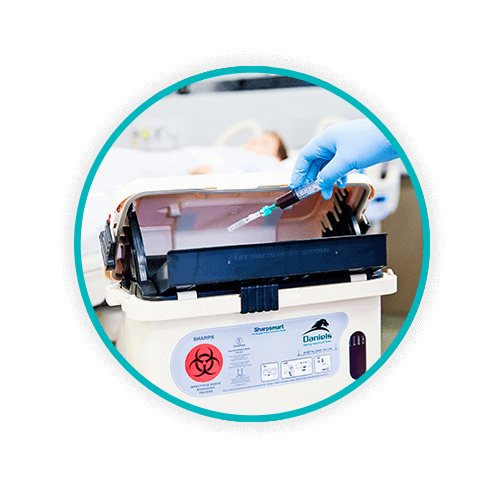Guide to Texas Medical Waste Disposal

Updated: August 27th, 2019
How to compliantly dispose of medical waste is a question that haunts many a clinician – don’t worry, Daniels Health is here to help!
Sharps and medical waste disposal guidelines often differ slightly from state to state – but all regulations have the same underlying purpose: to keep clinicians, patients, and the environment safe. Daniels Health has been offering safe medical waste containers, disposal, and education to Texas for decades. We’re a trusted partner of locals.
You may be adhering to federal biomedical waste management regulations (or at least we hope so), but are you familiar with Texas-specific codes and regulations? Federal and state regulations are not always the same. In fact, state regulatory guidelines regarding healthcare waste segregation, removal, and transportation are often more stringent than federal laws.
So, how does Texas define medical waste?
Specific terminology as well as definitions of various forms of medical waste are found in the Texas Administrative Code (TAC), Title 30, Part One, Chapter 326: Environmental Quality, the Texas Commission on Environmental Quality (TCEQ), and Medical Waste Management, respectively. What a mouthful, right?
Do you know Texas has regulations in regard to the volume of poundage a small quantity generator (SQG) or a large quantity generator (LQG) produces? To rephrase, do you know the volume regulations for a single physician’s office versus a large hospital? Do you know the average poundage that your facility produces? This information is something your medical waste disposal partner should easily be able to provide to you. Daniels Health partners with facilities to always be transparent about the volume of waste they are producing. In regard to generator sizes in Texas, a medical waste generator producing 50 pounds or less every month is considered a small quantity generator. Medical waste generators that produce more than 50 pounds a month are classified as large quantity generators. These generator sizes only refer to biomedical waste – not RCRA Hazardous waste (the generator classes are a little different for that stream).
Regulations differ based on this seemingly innocuous definition, so it pays to know. Seriously. Not following the guidelines for either can result in hefty fines and headaches. Saving more money means having more funds to fuel into clinician pay and patient care.
Hazardous medical waste is defined by the Texas Administrative Code (rule §326.3) as "any solid waste identified or listed as a hazardous waste by the administrator of the United States Environmental Protection Agency (EPA) under the Federal Solid Waste Disposal Act, as amended by the Resource Conservation and Recovery Act (RCRA) of 1976, United States Code 42, §§ 6901."
"Medical waste" as defined in 25 TAC sections §1.132, 25 TAC and § 1.134 consists of "treated and untreated special waste from care related facilities that is comprised of animal waste, bulk blood, bulk human blood, bulk human body fluids, microbiological waste, pathological waste, and sharps.” This is also defined under regulated medical waste definitions in the code of federal regulations, 49 §173.134 (a) (5) - but (and it always pays to read the small print), does not include medical waste produced on a farm or a ranch, nor does it include any nonhuman or artificial materials removed from a patient and those that are requested by the patient (yes, it happens), that can include such things as an orthopedic device or even a breast implant!
But get this, and this is where definitions and terminology are important: in Texas, you'll find what is defined as nuisance waste, such as 'any kind of waste that is stored, processed, or disposed of in a manner that causes the pollution of surrounding land, contamination of groundwater or surface water, breeds insects or rodents, or otherwise creates odors that are offensive to human safety, health, or welfare.' You may wish to review this ruling (definitions) of the Texas Administrative Code as it is rather eye-opening. Just as important, are specific regulations regarding the management and disposal of medical waste in the Lone Star state.
Management and disposal of medical waste in Texas 
The Texas Commission on Environmental Quality is very specific in regards to guidelines defining what type of wastes are considered medical waste, on-site storage of medical waste, authorized transport of medical waste, and on-site treatment of medical waste. Medical waste management guidelines for Texas are detailed and clear, if one just takes the time to read through them carefully. Take that time.
For example, do you know whether your facility is eligible for storage of on-site medical waste? In Texas, regulation 30 TAC §326.3 (14) specifies that SQGs and LQGs are not required to notify, obtain permits, registration, or other types of authorization in order to store medical waste on the site of the facility, but there's a caveat - the medical waste can only consist of waste generated on the site, it must be stored securely and cannot create a nuisance.
If management at your facility decides to treat medical waste on site, a number of regulations need to be followed (30 TAC § 326.39 through § 326.41), including but not limited to:
- utilization of appropriate and approved methods found under 25 TAC §1.136;
- adequate logs and maintenance records of treatment processes required under §§ 326.39 and 326.41; and
- treated medical waste must be disposed of in accordance with §§326.39 (c) and 326.41 (c)
In addition to that, a notification form (Waste Permits Division) for treatment of medical waste on-site must also be filed with the TCEQ regulatory agency. (Form TCEQ-20788).
Where does Daniels Health service in Texas?
All over! We are constantly working to grow our logistical footprint so we can provide the safest and most cost-effective solutions to as many healthcare facilities as possible from Plano through to Arlington. Feel free to reach out to one of our clinical experts today for a free waste management program consultation.
- To learn more about our medical waste disposal in Austin, Texas – click here
- To learn more about our medical waste disposal Houston, Texas – click here
- To learn more about our medical waste disposal in San Antonio, Texas – click here
How should I dispose of sharps? 
In many states around the country, including Texas, healthcare workers experience confusion about sharps disposal requirements. You’re not alone! Education is an ever-going journey. Is there a difference between regulations governing a healthcare facility vs a household user such as those who self-inject?
The TCEQ publishes an informative sheet regarding disposal of household syringes that guides households on proper disposal methods that will reduce risk of fines or penalties for noncompliance. The TECQ defines and classifies sharps as a type of medical waste and therefore guidelines fall under medical waste regulations in the state of Texas.
Here's where reading the small print comes in handy: follow guidelines found under 25 TAC §1.136 [as well as §326.23 (e)] regarding shipments of treated medical waste including sharps or residuals of sharps that originate from a healthcare facility. In such cases, documentation and written statements must accompany the shipment verifying that such shipments to solid waste landfills have been treated by an approved method in accordance with the regulation.
Disposal, segregation, placement, and types of sharps containers are found under rule §326.3 (definitions) and regulations found under 25 TAC §1.132 (also definitions) as well as guidelines regarding the management and disposal of medical waste.
Most states adhere to guidelines provided by the EPA in regards to disposal of medical sharps and needles. Texas regulations (1999 TEX HB 2085), specifies a number of provisions regarding needle safety legislation.
Daniels Health - Texas' preferred healthcare waste management partner
Daniels Health is a leader in the field of solutions, research, and resources when it comes to healthcare waste management, development of safe, secure, and reusable sharps container methodologies, and volume-reducing waste segregation practices for numerous waste streams. Our goal is not only to reduce needlestick injury, but to improve sustainability, reduce CO2 emissions, and drive long-term clinical outcomes for all medical waste generators. We hope that whenever you have a question about medical waste disposal in Texas, that you’ll give us a holler.
If you would like further help navigating Texas' medical waste regulations, call one of our clinical experts today! To get a quick overview of how we partner with you locally, visit our Texas page here.
